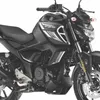3 Yamaha R15 v3.0 based motorcycles we want to be launched in India
These Yamaha R15 v3.0 based motorcycles, available in the ASEAN region, can be perfect for the India market with slight modifications.
The Yamaha R15 v3.0 is one of the best learner’s motorcycles retailed in India and ASEAN without burning a hole in your pocket. The motorcycle has a committed riding position while the chassis is capable enough to gain experience before upgrading to a bigger motorcycle.
However, the best part of the motorcycle is the powertrain. The engine offers technology previously unseen, even in several segments above it.
R15’s 155cc single-cylinder, liquid-cooled mill gets Variable Valve Actuation (VVA). For years, the R15 has been known for its top-end grunt. However, Yamaha changed that with the introduction of VVA technology.
It utilises two intake valve cams, one for low to mid-range engine speeds and another for high engine speeds. They switch at 7,400 rpm mark, helping the engine produce ideal amounts of power and torque across all engine speeds.
Yamaha has taken the game a league ahead by utilising this powertrain to create several successful products. These include the Aerox maxi scooter, the NMax 155, and the new dual-purpose motorcycle WR 155 R. The Japanese two-wheeler manufacturer has taken the South-East Asian market by storm with as many as six products.

However, India has so far only seen the Yamaha R15 v3.0 and the street-naked MT-15. Both motorcycles have been modified to make them more accessible to Indian customers. These include no upside-down front suspension on both, and no lightweight aluminium swingarm for the MT-15.
Here are three more two-wheelers Yamaha can launch in India based on the Yamaha R15 v3.0 from the ASEAN region:
Yamaha WR 155R
This dual-purpose motorcycle takes the best from the R15 and adds several parts, which help it take on different terrains. In the WR 155R, Yamaha has dropped the delta-box frame for a semi-double-cradle frame.
The bodywork has been kept to a minimum while the headlamp is a halogen unit instead of the usual LED setup. The motorcycle uses a tall front fender and a tall set single piece handlebar. The latter allows easy handling when standing on the footpegs.

Yamaha WR 155R gets a small 8.1 litre fuel tank while the conventional fork up front provides more travel. Additionally, the seat has been built typically like an enduro machine. Besides that, the WR 155R has a high ground clearance of 245 mm, which comes at the cost of seat height. The latter in the dual-purpose motorcycle stands at 888 mm.
The VVA powertrain in the Yamaha WR 155R produces a reduced power output of 16.7 PS while the torque takes a small hit to 14.3 Nm. Braking duties are administered by petal discs at both ends (240 mm front and a 220 mm unit in the rear).
Also, the motorcycle is shod with a large 21-inch front wheel and an 18-inch unit in the rear. This setup further helps in taking on the road less taken by allowing the motorcycle to take on obstacles easily.
If launched in India, the Yamaha WR 155R could be positioned against the Hero XPulse 200, albeit with a slightly higher price tag of around Rs 1.4 lakh.
Yamaha NMax 155
The Japanese two-wheeler manufacturer has recently updated the NMax 155 for the Indonesian market. This R15 v3.0 based automatic scooter has been rumoured to be heading to India by several media outlets and the latest updates will add more stars to its line-up.
The scooter has gained new, sleeker-looking LED headlamps, and new body styling.

The NMax 155 is fitted with a Smart Motor Generator, Start-Stop function, keyless ignition, hazard lights, and an electric power socket. Besides that, the scooter even gets a traction control system, a feature previously unseen in the segment. Also, the scooter gets conventional telescopic fork up front and twin gas-charged springs in the rear. Yamaha NMax 155 is offered with a small LCD instrumentation console with optional Bluetooth connectivity.
Smartphone connectivity in the affordable two-wheelers was first introduced in India by TVS with the NTorq 125. The NMax 155 will be a perfect rival to the NTorq 125 despite being a more premium offering.
In terms of powertrain, the automatic scooter’s engine produces a reduced 15.3 PS of power and 13.9 Nm of torque. Brakes include discs at both ends. Yamaha India may lose the rear disc brake with a drum unit to keep the price under check. Even the traction control system may be dropped, which will further help in reducing production costs.
If launched in India, NMax 155 will be a positioned against the Suzuki Burgman Street 125, TVS NTorq 125, and Aprilia SR 150, with a price tag of more than Rs 1 lakh.
Yamaha XSR 155
The neo-retro styled XSR 155 is a unique offering by Yamaha in the performance 150-160cc segment. The motorcycle is shod with a circular LED headlamp and a round LCD instrumentation.
Carrying forward the classic image, the XSR 155 gets a flat, single-piece seat, and a fuel tank similar to the XSR 900 retailed in European markets.

Just like the rest of the Yamaha R15 v3.0 based motorcycles from ASEAN regions, the XSR 155 too gets an upside-down front suspension. The retro-motorcycle is also lighter than the fully faired bike by six kg and tips the scales at 134 kg. The motorcycle has a ground clearance of 170 mm and 810 mm seat height.
Its fuel tank can store 10.4 litres of petrol. The bike comes in colour options of 80s Sport Heritage (White and Red), Premium (Silver with tan-brown leather seat cover), Elegance (Black), and Wanderlust (Olive Green), which lend an aura of different variants without making any changes to the motorcycle.
Riding the neo-retro wave, the Yamaha XSR 155, if launched in India can be a kickstarter to a whole new segment. The Indian variant may lose the upside-down front suspension for a more affordable conventional, right-side down fork as seen in the Indian version of MT-15.
Besides that, an Indian version of the XSR 155 may also get the box-style swingarm from the street-naked.
If launched in India, expect the Yamaha XSR 155 to carry a starting sticker price around Rs 1.4 lakh.
(Edited by Saheli Sen Gupta)









